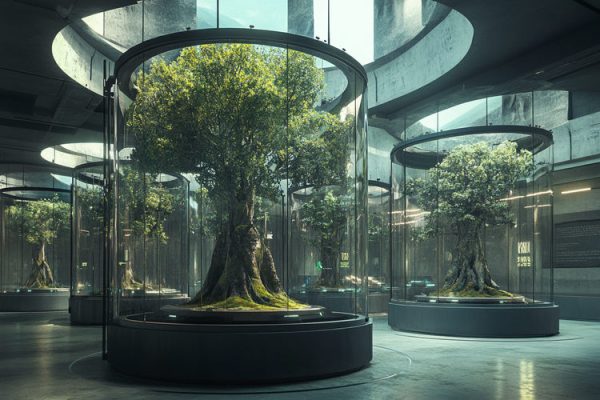We are facing the extinction of wood.
Let me elaborate.
- I’m referring to the extinction of wood, not trees.
- By extinction, I mean an overall end to the use of solid wood, not an absolute cessation of all wood and wood-like products.
Solid Hardwood Design: “Extinct In The Wild”
When dealing with the conservation of tree species, the IUCN has a special intermediate category which they call “Extinct In The Wild.” That’s to say, a tree may become endangered in its natural habitat, but before it’s completely wiped off the map like the dodo, there’s a phase when a species is no longer existing in the “wild” but is sustained and nurtured by humans solely in captivity.

Perhaps the best example of this phenomenon is with the common domesticated sheep (Ovis aries). This species no longer has any known natural distribution throughout the entire world. While there are other species of wild sheep represented, when it comes to the common Ovis aries, there are no ‘wild’ sheep. Yet despite this species being ‘extinct’ in the wild, the FAO reports that there are now approximately 1.2 billion sheep in the world. That’s billion with a b.
Domesticating Trees
Of course, livestock is not the only thing that humans have tamed and harnessed for utility. There are a handful of wood species—some quite well known—that are very nearly extinct in the wild, but nonetheless are propagated and sold quite extensively. One such species is Monterey pine, which is known more commonly in the context of carpentry as radiata pine (Pinus radiata). Though widespread commercial harvesting of wild trees has been halted for decades, radiata pine is a very widespread plantation species cultivated (and sold) worldwide.
But it can be very helpful to ask the question: why did sheep become a totally domesticated species? Why did the proportion of domesticated to wild sheep tilt to such an extreme that it is now at a ratio of 1,200,000,000 to 0? Along these lines, why don’t we simply go out and hunt for wild cattle instead of investing all the time and resources of breeding, sheltering, and feeding them?
At the risk of oversimplifying things, I will guess that the main reason for this is because the demand for these things has outpaced the supply. Today, with some 8 billion plus mouths to feed, we simply can’t rely on chancing upon a meal out in the wild to reliably satisfy our appetites.
When Demand Vastly Outpaces Supply
While this extreme supply and demand mismatch has long been abundantly clear in the realm of food, the same cannot be said for our supply of lumber. In the case of wood, we have been able to subsist on “wild caught” specimens for a really long time. But
I believe the day is coming (actually, it may already be here) where fine furniture and thoughtful solid-wood design will be so uncommon that it will only be viewable as museum specimens, historic house tours, or in the hands of a group of devoted enthusiasts just crazy enough to preserve one of mankind’s oldest and most cherished crafts.
I’ve just taken up seasonal residence in a relatively newly-constructed condo (about 12 years old at the time of this writing). There is wood everywhere. Floors, baseboards, cabinets, storage, furniture—it’s all wood. Except that it isn’t actually wood at all, and it’s not even veneer.
Doesn’t it always seem to go that you don’t know what you’ve got till it’s gone.




